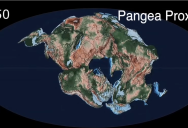New Animation Shows How The Next Supercontinent Might Form In The Next 20 Million Years

Even when we see pictures or mockups of how our Earth looked in the distant past, it can be hard to imagine a place so different from the one we know now.
It’s even weirder to try to imagine what it might look like in the future, even if human beings won’t be around to witness it.
The previous supercontinent, Pangea, began to break apart into the continents we know and love around 200 million years ago.
Plate tectonics are still in motion, however, which means that – slowly but surely – those giant land masses are still moving.

German meteorologist Alfred Wegner first suggested plate tectonics and continental drift was a thing back in 1912, but it wasn’t until technology like echo sounders and magnetometers evolved enough to confirm it in the 1960s.
Since then, scientists studying ocean ridges have been able to put together models and incorporate new data to give us a pretty sophisticated guess about what Earth might look like in the (very distant) future.
This team looked at how the movement of tectonic plates affects tides and predicted the emergence of another supercontinent down the line.

Oceanographer Mattias Green, lead author of the study, admits that none of this will affect anyone living today in the slightest – but that doesn’t mean it’s not important.
“It probably doesn’t mean anything to humans now in our lifetime. But it does enhance our understanding of interactions between plate tectonics, Earth’s climate system, its oceans, and even how the evolution of life is, at least to some extent, driven by this tidal process.”
Earth is going through a period of strong tidal energy right now, and they propose it will last around 20 million years.
The ocean basins will form one huge body of water as the next supercontinent forms, and will have low tidal energy.
This would likely result in less oxygen and nutrients in the ocean, leading to a massive loss of life in the depths.
The animation is super cool, but obviously it’s not going to be all fun and games for whatever – and whoever – is around to see it.
If you thought that was interesting, you might like to read about why we should be worried about the leak in the bottom of the ocean.

Never Miss a Story
Sign up to get our BEST stories of the week straight to your inbox.




